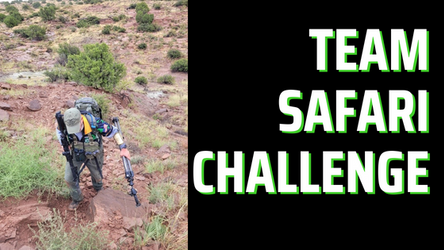Team Safari 2022
Posted by Monte Long on Mar 17th 2023
Normally, I write about shooting drills. Drills are one of the ways to practice and improve your skills as a shooter. Sometimes, I write about a standard or qualification course of fire. Standards and quals are a way of testing your skill set so that you can determine if you’ve improved or what you should work on improving. Another way to test your skill set is to go shoot a match. Today, I want to talk about a specific match.
The Accufire Tech Team Safari was held October 14-16, 2022 at the JP Blue Steel Ranch just outside of Logan, NM. It’s an annual event that is put together and run by Zak Smith and Jimmy Holdsworth of Competition Dynamics and their team of range officers. As the name implies, it is a team match consisting of two people – one team member uses a precision rifle and a pistol and the second team member carries a carbine and a pistol. It’s a great match to test your skills as a shooter AND as a team member.
The match consists of three field courses, North, West and South, and between two and four assault courses, depending on the year. Teams shoot one field and one or two assault courses per day. The field courses are arranged on the North, West and South sides of the property and involve quite a bit of movement – anywhere from two to three miles total. Assault courses are more akin to a 3 gun or USPSA style stage, with a team component mixed in.
Field courses start and end at the Front Range of the property. Teams are allowed to use nearly any piece of gear that they want to shoot, provided the team is willing to carry it on a two plus mile trek around the New Mexico desert. When it’s a team’s turn to head out, they follow a trail marked with various colors of survey tape. The team follows the trail along the field course and stops at 8 shooting areas along the way. At each shooting area, the team in front of yours is waiting to serve as your range officers/score keepers when your team shoots.
Shooting positions can be either a 1X6 or a 2X3 – one shooting position with 6 available targets OR two shooting positions with three available targets that are engaged from both positions. From the shooting position (or the initial shooting position on a 2X3), there will be a set of clearly marked lateral limits that the range officers will point out. The lateral limits can, depending on the stage, be extremely narrow or dauntingly wide. Some targets are readily visible while others can be difficult to find. On the go signal, your team has six minutes to find, range and engage the targets – three for the carbine shooter and six for the precision rifle shooter. The number of rounds that a carbine shooter can fire at his or her targets is only limited by how much ammo they want to carry and the time available to them. The teammate with the precision rifle gets one round per target – they are, after all, shooting the precision rifle.
Targets are provided by AA Targets and can be small diamonds, large diamonds or rectangles. Regardless of the size and shape, they are some variation of this:
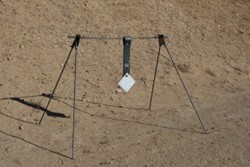
photo courtesy of AA Targets
Of course, bright white targets would be easy to spot in the New Mexico desert. Zak and Jimmy give them a good solid coat of grey or black paint. It makes spotting the targets a bit more entertaining – and definitely more difficult.
Sometimes, you can see and engage everything from prone. Other times, well, there is a reason that teams that have shot the match before typically carry at least one tripod for the team. You’re probably going to want one for some of the shooting positions.
There’s a lot going on with the field courses. You need to be able to find targets that may or may not be readily visible quickly and you have to be able to effectively communicate their locations to your teammate – and to the RO’s. You need to be able to accurately range the targets and, on occasion, be able to recognize when you’re ranging something other than the target. And you’ve got to be able to make a good wind call – the river bottom and the network of canyons and draws on the property create some difficult wind conditions.
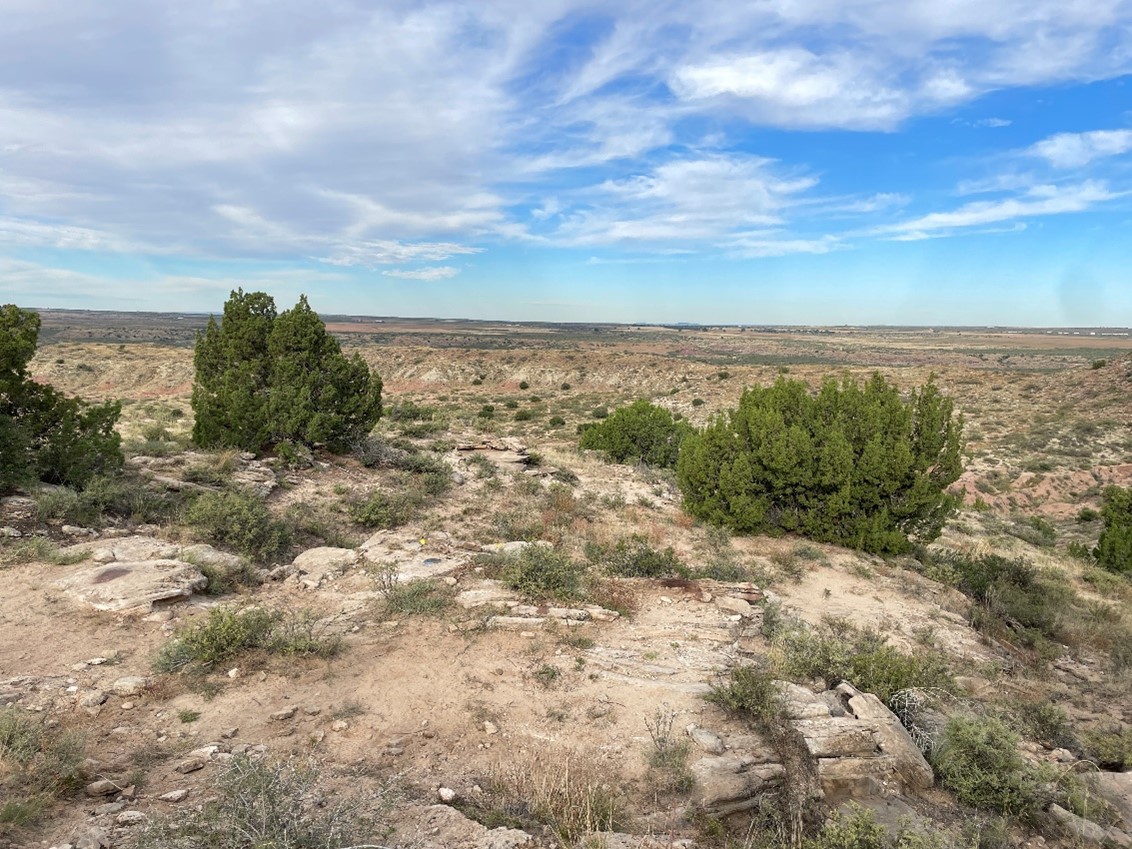
Above: Approach to a shooting area on the West field course from the 2022 match. You can just see the blue/black dot for the shooting position and a bright yellow mark for one of the lateral limits. There are three targets just to the right of the big cedar left of center.
Below: Shooting area on South field course from 2019.
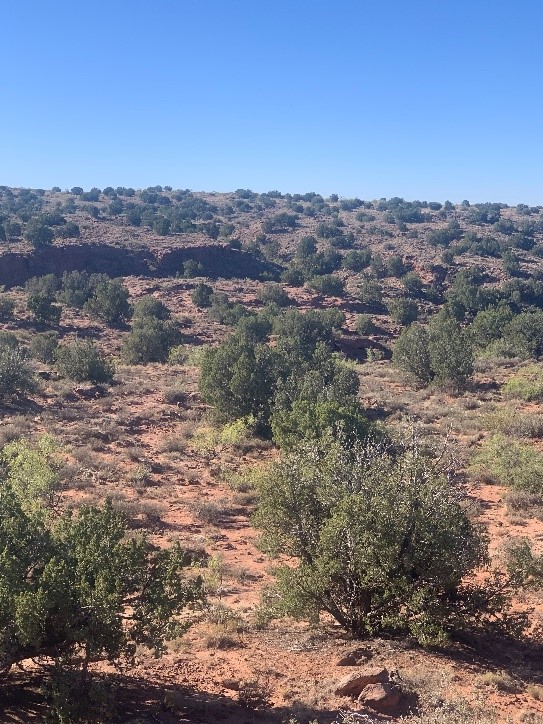
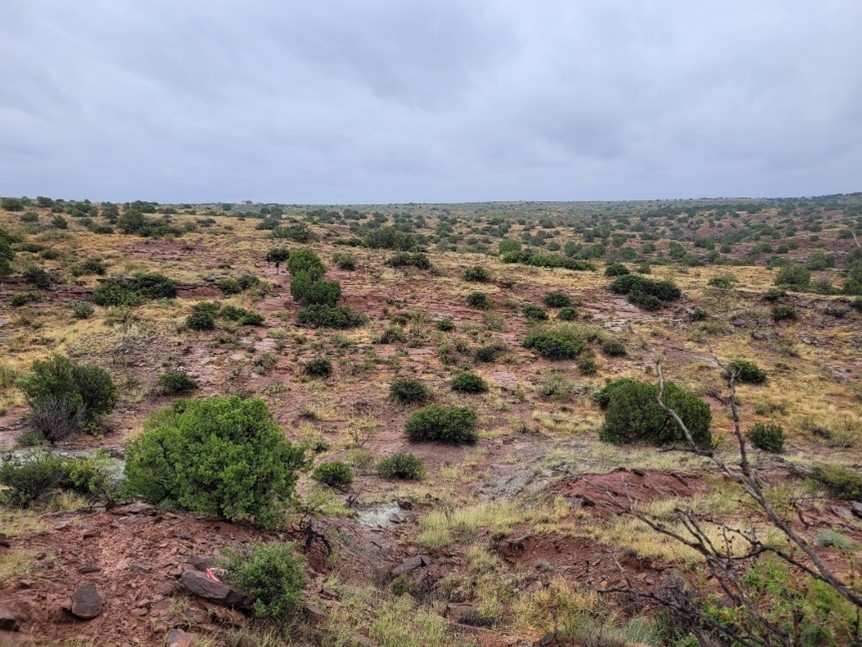
Above: Looking east from the highest point on the South field course.
Below: The walk up to the high point on South field course.
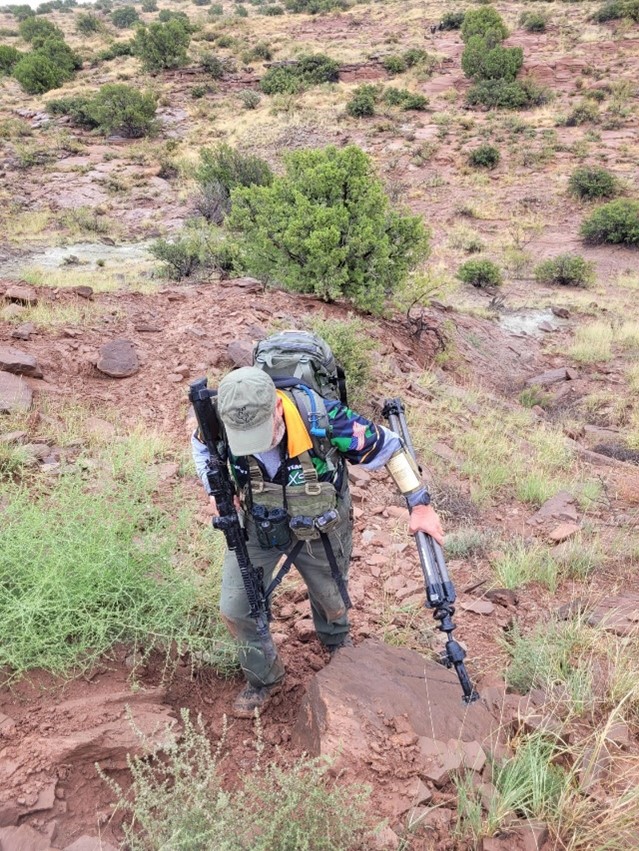
Assault courses tend to be scattered around the property and have varied quite a bit over the years. This year, we had two assault courses to contend with. Assault 1 was on the front range and was a long gun only course of fire. The team started with one teammate with an unloaded long gun at the low ready. The second teammate was sitting down, facing up range looking at a range officer. There was a cardboard target with a series of black and white head shots down range at about 50 yards. Each photo was numbered, and there was a corresponding steel target down range at 300 yards. On the go signal, the teammate that was facing up range was shown a picture. He or she had to describe the person in the photo to their teammate. Once the teammate identified the target on the cardboard at 50 yards, he called out the number and then had one round to engage the steel target at 300 yards. Once the first teammate had an opportunity to engage six targets, the teammates switched positions and repeated the drill. Teams had a maximum of four minutes to complete the course of fire.
Clear, concise communication with your teammate was vital to this assault course. By using black and white photos, Zak and Jimmy increased the necessity for clear communication and detailed descriptions AND increased the difficulty of the drill.
Assault 2 was in a large caleche pit on the North field course. The team started with both handguns loaded and holstered and both long guns slung empty. There were six pieces of pistol steel down range directly in front of the team to be engaged with pistols and four long gun targets 90 degrees to the right at 250 yards, with multiple firing lines marked. There was also a Rescue Randy dummy. The team started at around 50 yards. On the buzzer, each teammate was to engage the steel targets directly in front of them with a handgun. If all hits were achieved with no misses, the team moved to final pistol position for the rifle portion of the course.
If either teammate missed a pistol target at any time, the team had to holster their pistols and move to the next firing line. While carrying Randy’s heavy ass. Carry. Not drag. Did I mention that Randy is a bit on the heavy side? At the next yard line, the process was repeated – each team member attempted to hit the pistol targets with only six rounds. Any miss required a re-holster and movement to the next line, along with Randy. From the final position, about 20 yards from the targets, the team was allowed to shoot handguns until they had achieved twelve hits – six per team member – and then unloaded and holstered their pistols.
At that point, each team member had four targets to engage with the long guns. Due to terrain and foliage, the targets had to be shot off hand or using your teammate for support. This was a timed stage with a four minute par time.
While the communication between team mates on Assault 2 wasn’t as much as on the rest of the course, the team did need to work together to get Randy from position to position and to get their rifle hits.
The match, as always, was excellent! Despite some rain on Sunday morning, the match ran well, and all of the shooters had fun. I’m already working on what I’ve decided I need to change before next year.
If you like to shoot competitively, especially with a rifle or carbine, and you want to see how well you can work with a teammate, you should definitely make sure to sign up for this one!
A big thank you to Jimmy, Zak, Stan and the Competition Dynamics Crew for a great match!
Thank you to all of the sponsors!
Red American Cerrakote


 XS INDEPENDENCE Day Sale | 30% off sitewide | + Orders over $100 get a FREE patch | Discount applied at checkout
XS INDEPENDENCE Day Sale | 30% off sitewide | + Orders over $100 get a FREE patch | Discount applied at checkout
